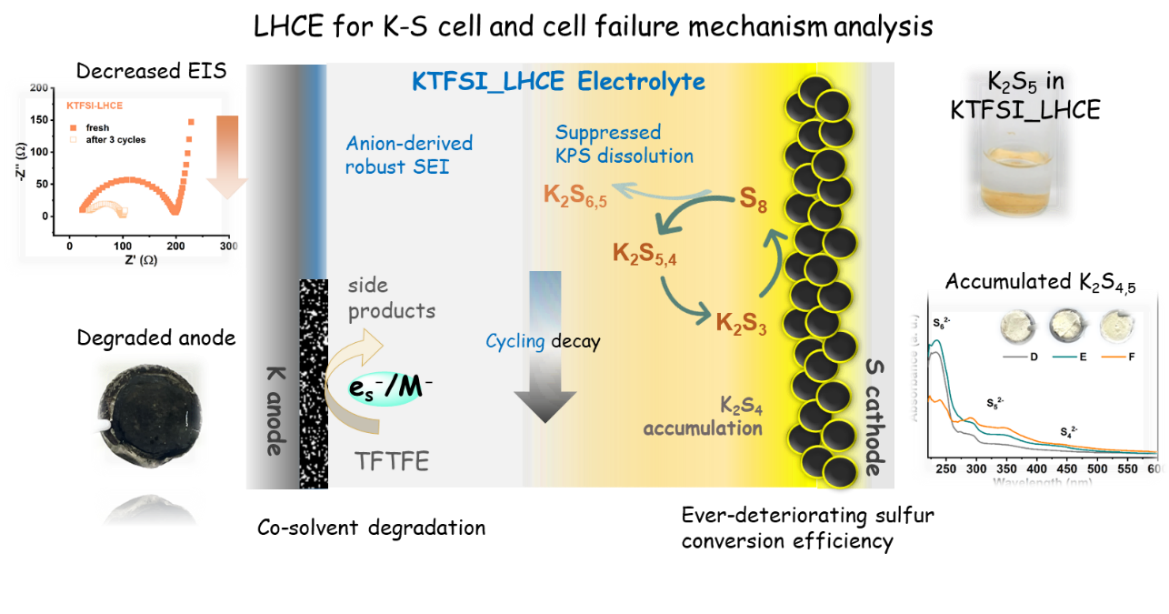Recently, a research team led by Dr. Lei Qin from theInstitute forAdvanced Study at Shenzhen Universitypublished a research paper titled “Empowering the Potassium-Sulfur Battery with Commendable Reaction Kinetics and Capacity Output by Localized High-Concentration Electrolytes” in the ACS Applied Materials & Interfaces.This work focuses on electrolytetuningtechnology and pioneersthe development ofan ether-basedlocalized high-concentration electrolyte (LHCE)forhigh-energy-density potassium-sulfur (K-S) batteries. This electrolyte formulation significantly reduces the solubility of intermediate products(namely long-chainpolysulfides)in the electrolyte, effectively inhibiting the shuttle effect of polysulfides.Additionally, it can significantlyenhancethe interfacial reaction kinetics between the electrodes and the electrolyte. Dr. Lei Qinserves astheco-corresponding author of the article.
Potassium-sulfur(K-S)batteries are one of thepromising high-energy-density candidatesbeyondcurrent lithium-ion batteries. Nevertheless,thepracticalutilization ofK-S batteriesis largelyhindered due to the dissolution and shuttle effectof the cathode redox intermediates and the scarcity of an effectiveanode protection layer in conventional electrolytes. Herein,electrolyte engineering is applied to formulate an ether-basedlocalized high-concentration electrolyte (LHCE) for the firsttimein aK-S cellwith the mitigated parasitic effect of polysulfidedissolution and shuttle and the tuned anode-electrolyte interfaceproperty. A nonsolvating and polysulfide-stable fluoroether issieved as a cosolvent in such an LHCE, which possesses the ultralow polysulfides solubility due to less roaming solvents and thusalleviates the polysulfides shuttle effect. The anion-derived solid electrolyte interphase enriched in inorganic components isconstructed due to the strengthened cation-anion interplay in the primary solvation sheath and highlighted with acceleratedinterfacial kinetics in aK-Scell. It is validated that the proposed LHCE unlocks the theoretical capacity of theK-Scell based onthe conversion between S and K2S3. It is further revealed that the lifespan is limited to the anode corrosion with severe cosolventdegradation caused by limited solvating solvent compatibility with metallic K, and the inevitable byproduct accumulation at the Scathode.
Therefore, one of the focuses of subsequent research is to find a more stablesolvatingsolvent to construct the LHCE system. Nevertheless, this workdemonstrated here stillutilizes the unique “lean solvent” solvation structure design of LHCE, highlighted with fewer roaming solvating solvents and highsalt-to-solventratio,and controlsthe solubility limit of polysulfides, overcoming the reaction kinetic obstacles and capacity output limitations existing in K-S batteries based on conventional low-concentration electrolytes.This work shines a light on the electrolyte design perspective for full utilization andan in-depthmechanisticunderstanding ofhigh-energy-densityK-S batteries.
This research was funded by the National Natural Science Foundation of China (52301280)andthe Postdoctoral HWYC Program.
Original Article Link: https://pubs.acs.org/doi/10.1021/acsami.3c19583

Figure 1 Graphic Abstract


